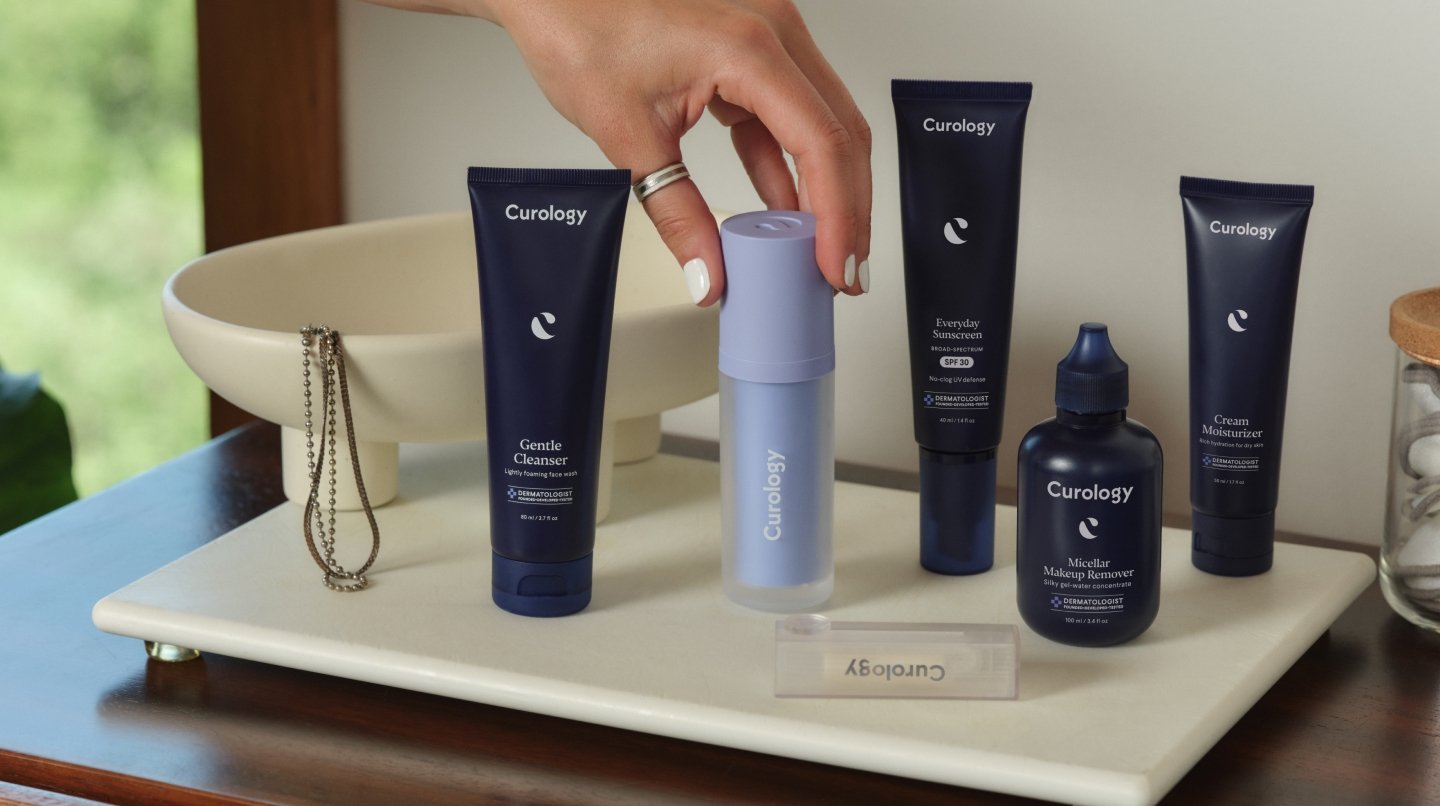How it works:
Share your skin goals and snap selfies
Your dermatology provider prescribes your formula
Apply nightly for happy, healthy skin
How it works:
How it works:
Share your skin goals and snap selfies
Your dermatology provider prescribes your formula
Apply nightly for happy, healthy skin
How it works:
What causes a stye?
How you can keep these tender bumps away.



If you’ve ever experienced a red, tender bump near the edge of your eyelid, you know how annoying it is to deal with a stye. While styes may not be a cause for alarm, they can certainly be uncomfortable—so of course you’d want to know how to best prevent them from happening in the first place!.
Never fear: Our dermatology providers are here to explain what causes a stye and what you can do about it. Here, we’ll explain why they develop, how they differ from other eye conditions, and the best practices to keep your eyes healthy and stye-free.
What is a stye?
A stye—also known as a hordeolum—is a red, painful lump that forms near the edge of an upper or lower eyelid. It often resembles a boil or a pimple and is usually filled with pus. While styes typically form on the outer part of your eyelid, they can occasionally develop on the inner part as well. Styes usually affect only one eye, but it’s possible to have multiples at the same time.¹
It’s important to know the symptoms so you can distinguish a stye from other eye conditions and get proper treatment.
Stye symptoms
The signs and symptoms of a stye include a small pustule on your eyelid, which may look similar to a boil or a pimple. A stye can cause eyelid pain and swelling at the base of your eyelash. These symptoms can be uncomfortable, but they usually resolve on their own or with the help of proper treatments.²
If you have swelling, redness, and watery eyes without a lump, it's more likely that you have conjunctivitis or blepharitis. Whereas if you have a hard lump that isn't very painful, it's more likely to be a chalazion rather than a stye—more on that in a moment!³
The types of styes and their causes
There are two main types of styes: External hordeola, and internal hordeola.
External hordeolum
An external hordeolum is a condition that occurs at the base of your eyelash, and is mostly caused by an infection in your hair follicle. This type of stye often looks like a pimple and may be identified by its red, swollen appearance. External hordeolum can cause discomfort or pain, but usually resolves on its own or with appropriate treatment.⁴
Internal hordeolum
An internal hordeolum is a type of stye that occurs inside your eyelid. Most internal hordeola are caused by an acute bacterial infection of the meibomian glands, which are oil-producing glands in your eyelid.
If you have a condition called blepharitis, which causes redness and swelling at the base of your eyelashes, you may be more prone to developing this type of stye. Internal hordeolum can be uncomfortable and may require treatment to alleviatesymptoms and resolve the infection. However, both internal and external hordeolum are treated similarly.⁵
Chalazion: Bumps that may be mistaken as styes
A chalazion is one of the most common inflammatory lesions of the eyelid, characterized by slowly enlarging, non-tender eyelid nodules. It occurs when there’s inflammation and obstruction of an oil-producing gland in your eyelid, which results in a swollen bump on the eyelid.⁶
Initially, a chalazion may not cause any pain, and you might not even realize you have one. However, as it grows, the affected eyelid can become red, swollen, and sometimes tender to touch. If the chalazion becomes large, it can press on your eye, leading to blurry vision.⁷
Distinguishing between a stye and a chalazion can sometimes be challenging, as both conditions can cause swelling in your eyelid. However, there are a few key differences between the two.
A stye is typically very painful and often appears at the edge of your eyelid, usually resulting from an infected eyelash root. The swelling in a stye can sometimes affect your entire eyelid. In contrast, a chalazion is not usually painful and tends to develop further back on your eyelid than a stye. It results from a clogged oil gland and rarely causes the entire eyelid to swell.⁸
What increases your risk of developing a stye?
While styes are very common, their exact cause is unknown—and every age and demographic can experience them. However, there’s a slight increase in occurrence in patients between the ages of 30 to 50.⁹
Other than that, there are no known differences in prevalence among populations. However, it has been noticed that certain chronic conditions can increase your risk of developing a stye. Patients with seborrheic dermatitis, diabetes, and high serum lipids may be at a higher risk for developing this eye condition.¹⁰
Understanding the risk factors and recognizing the symptoms of a stye can help you identify this common eye condition. If you do experience a stye, you should know the appropriate treatments to alleviate your discomfort and promote healing.
Treating a stye

To treat a stye, you can apply a warm compress to the area for 15 minutes, four times a day.¹¹ This can help alleviate discomfort and promote healing. In some cases, a medical provider may prescribe erythromycin ointment to be applied twice daily to further aid in the recovery process.
A stye is typically a self-limiting condition and healing usually occurs within a week. By using warm compresses and erythromycin ophthalmic ointment as needed, you can hasten the recovery process and prevent the spread of infection, ensuring a swift return to normal eye health.
How long will it take to get rid of my stye?
Styes typically develop quickly, but also heal relatively fast. The pus inside the stye usually drains on its own after about a week, and the inflammation subsides in this timeframe as well.¹²
This quick resolution is one of the ways you can differentiate your stye from other conditions such as a chazalia. The swelling associated with chalazia develops more slowly and may take longer to resolve.
Unlike a stye, chalazia can take weeks or even months to go away completely. In some cases, they might not resolve on their own and may require additional medical intervention.¹³
How to prevent styes
To prevent styes, it's essential to maintain good facial hygiene. Some effective measures you can take include:¹⁴
Washing your hands thoroughly and often, especially before touching your face and eyes.
Washing your hands before and after removing contact lenses
Washing your face to remove dirt and/or makeup before going to bed.
Throwing away eye makeup every six months
Taking fish oil orally to help prevent the plugging of your oil glands.¹⁵
Avoid sharing towels with someone who has a stye to prevent the spread of infection.
By following these hygiene practices, you can significantly reduce your risk of developing styes and maintain good eye health.
When to see a doctor
While most styes heal on their own within one to three weeks, there are certain situations when you should see a dermatology provider.
Consider seeking medical attention if:¹⁶
The pain or swelling worsens after several days.
Another stye appears.
You develop a fever or vision problems in association with the infection.
In these cases, consult a medical provider right away to ensure you receive proper diagnosis and treatment.
Take care of your skin with custom Curology products
One of the best ways to prevent styes and other skin lesions, is by keeping your skin clean with the right products. Though our products are not designed to treat styes, they can help you battle a wide range of other skin complications.
Get your personalized skincare routine with Curology
Get your personalized skincare routine with Curology


Curology offers customized skincare solutions tailored to your unique needs, targeting issues such as acne, hyperpigmentation, and rosacea.
If you're interested in improving your overall skin health, check out our dermatologist-designed Curology products to help keep your skin clear and glowing.
FAQs
A stye is filled with pus, which is a thick fluid containing dead white blood cells and bacteria that have accumulated as a result of an infection.
The fastest way to cure a stye is to apply warm compresses to the affected area, as this can help promote healing. In most cases, a stye will go away on its own without requiring specific treatment. If a stye persists or worsens, your doctor may recommend additional treatments, such as:
Antibiotic eyedrops or topical antibiotic cream to apply to your eyelid. This can help treat the infection if it doesn't resolve on its own.
Oral antibiotics, which may be prescribed if the infection persists or spreads beyond your eyelid.
A small incision made by your doctor, to drain the pus and alleviate the infection.
Remember, it's crucial to consult with a healthcare professional for personalized advice and treatment options if you're experiencing a persistent or worsening stye.
Although styes themselves are generally not contagious, the bacteria causing the stye can be spread through contact. To minimize the risk of spreading bacteria from a stye, it's important to:
Wash your hands thoroughly before and after touching the stye.
Wash pillowcases frequently to prevent the spread of bacteria.
Avoid touching the stye unless you’re cleaning it or applying warm compresses.
By practicing proper hygiene and taking precautions, you can help prevent the bacteria from spreading to others or causing additional infections to yourself.
P.S. We did the homework so you don’t have to:
Willmann, D., et al. Stye. StatPearls. (2022, August 8).
Willmann, D., et al. Stye. StatPearls. Ibid.
Willmann, D., et al. Stye. StatPearls. Ibid.
Willmann, D., et al. Stye. StatPearls. Ibid.
Willmann, D., et al. Stye. StatPearls. Ibid.
Jordan, G.A. and Beier, K. Chalazion. StatPearls. (2022, August 1).
Jordan, G.A. and Beier, K. Chalazion. StatPearls. Ibid.
Jordan, G.A. and Beier, K. Chalazion. StatPearls. Ibid.
Willmann, D., et al. Stye. StatPearls. Ibid.
Willmann, D., et al. Stye. StatPearls. Ibid.
Willmann, D., et al. Stye. StatPearls. Ibid.
Informed Health. Styes and chalazia (inflammation of the eyelid): Overview. Institute for Quality and Efficiency in Health Care (IQWiG). (2019, December 5).
Informed Health. Styes and chalazia (inflammation of the eyelid): Overview. Institute for Quality and Efficiency in Health Care (IQWiG). Ibid.
National Health Service. Stye. (2021, February 26).
Macsai, M.S. The Role of Omega-3 Dietary Supplementation in Blepharitis and Meibomian Gland Dysfunction (An AOS Thesis). Trans Am Ophthalmol Soc. (December 2008).
American Academy of Dermatology Association. How to treat boils and styes. (n.d.).
Erin Pate is a board-certified Family Nurse Practitioner at Curology. She earned her Masters of Science in Nursing at Florida Atlantic University in Boca Raton, FL
* Subject to consultation. Subscription is required. Results may vary.

Curology Team

Erin Pate, NP-C
Related Articles
What is micellar water and how can you use it effectively?These are the best makeup removers for acne-prone skinIs Rare Beauty non comedogenic?Introducing the new micellar makeup remover by CurologyHow to take off your eye makeup the easy wayPopular Articles
Ask Curology: Is my cold breaking me out?Slugging: The dermatologist-approved skincare hack going viral on TikTokTretinoin vs retinol: What’s the difference?How to create a self-care routine that actually sticksYour 2023 skincare horoscopeTry prescription skincare
Get routine essentials

Good skin days ahead
- Breakouts
- Redness
- Fine lines
- Dark spots
- Hair thinning